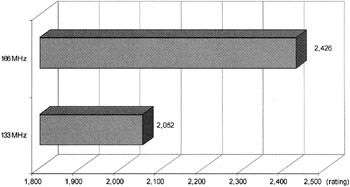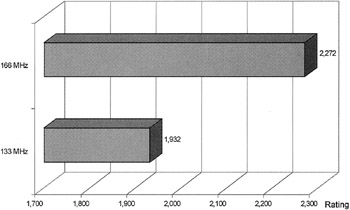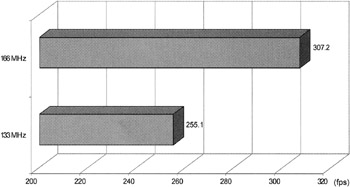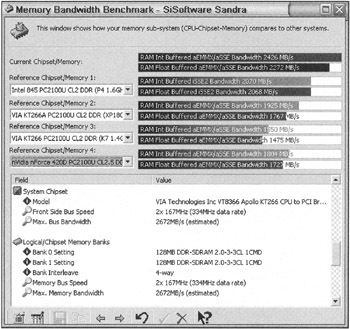Performance of a System with DDR333
|
| < Day Day Up > |
|
The previous test results were obtained on a computer equipped with DDR266 (PC2100) memory. It is reasonable to expect that replacing the memory with DDR333 (PC2700) will ensure further performance growth. However, the test memory module could operate on the nominal frequency (i.e., at an FSB frequency of 133 MHz and a memory frequency of 166 MHz) only when the following settings were chosen:
-
Bank Interleave — 4 Bank
-
DRAM Command Rate — 1T
-
DRAM CAS Latency — 2T
-
Trp — 3T
-
Tras — 6T
-
Trcd — 3T
| Test | Rating |
|---|---|
| SiSoftware Sandra (integer) | 2,052 |
| SiSoftware Sandra (floating point) | 1,932 |
| Quake III (fastest) | 255.1 frames per second |
Increasing the FSB frequency from 133 MHz to 166 MHz with a DDR333 memory module ensured performance growth with the same parameters. The test results are provided in Table 12.8.
| Test | Rating |
|---|---|
| SiSoftware Sandra (integer) | 2,426 |
| SiSoftware Sandra (floating point) | 2,272 |
| Quake III (fastest) | 307.2 frames per second |

Figure 12.7: Performance growth caused by increased frequency (SiSoftware Sandra, integer)

Figure 12.8: Performance growth caused by increased frequency (SiSoftware Sandra, floating point)

Figure 12.9: Performance growth caused by increased frequency (Quake III)
To simplify the analysis of how the memory module settings influence overall system performance, all test data are summarized in Table 12.9. In the Timing column, the memory module parameters are specified as followed: Bank Interleave, DRAM Command Rate, DRAM CAS Latency-Trp-Tras-Trcd.
| FSB/memory frequency (MHz) | Timing | SiSoftware Sandra integer/float | Quake III (frames per second) | Quake III, gain over default (%) |
|---|---|---|---|---|
| 133/133 | Disable, 2T, 2.5T-3T-6T-3T | 1,907/1,776 | 218.1 | default |
| 133/133 | 2 Bank, 2T, 2.5T-3T-6T-3T | 1,911/1,791 | 222.9 | 2.2 |
| 133/133 | 4 Bank, 2T, 2.5T-3T-6T-3T | 1,925/1,806 | 227.3 | 4.2 |
| 133/133 | 4 Bank, 1T, 2.5T-3T-6T-3T | 1,965/1,864 | 235.0 | 7.7 |
| 133/133 | 4 Bank, 1T, 2T-3T-6T-3T | 2,024/1,901 | 239.7 | 9.9 |
| 133/133 | 4 Bank, 1T, 2T-2T-5T-2T | 2,039/1,906 | 245.0 | 12.3 |
| 133/166 | 4 Bank, 1T, 2T-3T-6T-3T | 2,052/1,932 | 255.1 | 16.9 |
| 166/166 | 4 Bank, 1T, 2T-3T-6T-3T | 2,426/2,272 | 307.2 | 40.8 |
Note that if the memory parameters are set in a nonoptimal way, the computer performance drops significantly. The same is true if the user tries to economize and purchases poor-quality RAM; the performance can drop 5% to 10%. For example, the growth from 5 frames per second to 10 frames per second in the Quake III test corresponds to the difference between systems equipped with AMD Athlon XP 1700+ and 1600+.
When analyzing the results provided here, it is expedient to pay attention to the 166/166 MHz frequency mode. This ensures synchronous operation of the memory subsystem and processor bus. (In this frequency mode, the processor is overclocked from 1,400 MHz to 1,750 MHz.) In this mode, no delays are required for clock synchronization of the signals, which ensures high performance.
Starting from 166 MHz, the test motherboard (as well as many other motherboards) uses a factor of 1/5 for the PCI frequency (2/5 for the AGP). This guarantees operation of hard disk controllers and video adapters on standard PCI frequencies: PCI of 33 MHz, and AGP of 66 MHz.
Memory optimization is not limited to fine-tuning the parameters discussed here. This set of parameters is standard, and appropriate options are supported by most contemporary motherboards.
Choosing optimal parameters for memory modules ensures maximum performance. To achieve stable operation of the system at minimum values of the DRAM Timing parameter, it is expedient to increase the voltage supplied to memory modules (Vmem). The motherboard used in these experiments supported the following voltages: 2.55 V, 2.65 V, 2.75 V, and 2.85 V. However, this will increase heat generation, sometimes significantly. To avoid dangerous overheating of memory modules, it is expedient to use heatsinks for memory or organize other active cooling of the memory modules.

Figure 12.10: Computer performance with FSB and memory frequencies of 166 MHz (SiSoftware Sandra)
|
| < Day Day Up > |
|
EAN: 2147483647
Pages: 111